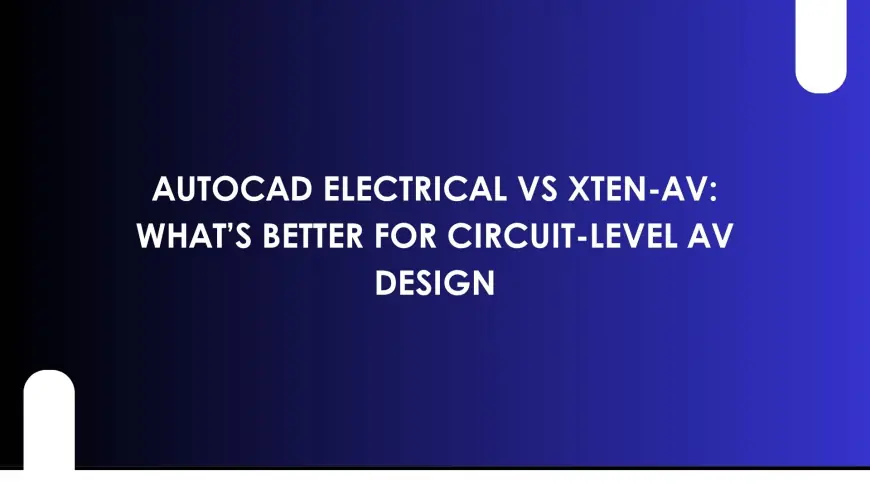AutoCAD Electrical vs XTEN-AV: What’s Better for Circuit-Level AV Design
This blog takes a deep dive into the key differences, strengths, and limitations of each to help you choose the best fit for your AV projects.

When it comes to designing AV systems at the circuit level, precision, speed, and clarity are everything. Professionals need tools that are not only powerful but also purpose-built for the demands of AV projects. Two popular platforms often come into this conversation—AutoCAD Electrical and XTEN-AV. While both tools offer diagramming capabilities, their core functionalities and workflows are quite different.
XTEN-AV is a next-generation AV design and documentation platform, tailored specifically for the AV industry. On the other hand, AutoCAD Electrical is a robust tool widely used in electrical engineering, known for its detailed circuit design capabilities. So, how do these platforms compare when it comes to AV-specific circuit-level design tasks? This blog takes a deep dive into the key differences, strengths, and limitations of each to help you choose the best fit for your AV projects.
XTEN-AV: Built for AV Professionals
XTEN-AV is a cloud-based AV system design and documentation platform that combines automation, real product libraries, and smart layout features. It focuses on helping system integrators, consultants, and AV engineers build complete AV schematics, signal flows, rack layouts, and cable schedules—all in one unified environment.
XTEN-AV streamlines circuit-level design by offering:
-
Drag-and-drop schematic creation
-
AV-specific symbols and block libraries
-
Auto-routing of connections and signals
-
Real-time bill of materials generation
-
Cable labeling and IO-level accuracy
-
Revision control and collaborative tools
It is more than just drawing software. It is a smart, AV-focused design tool that helps engineers move from concept to completion without redundancy or confusion.
AutoCAD Electrical: A Powerhouse for Electrical Design
AutoCAD Electrical is a part of the Autodesk suite and is designed for electrical control systems. It includes features for PLC design, panel layouts, circuit ladder diagrams, and electrical wiring schematics. Engineers from industrial automation, machinery, and process control industries widely use it for its depth and flexibility.
AutoCAD Electrical includes:
-
Symbol libraries for electrical components
-
Schematic design tools for power and control circuits
-
Real-time error checking
-
Wire numbering and component tagging
-
Custom reporting and project navigation
While it is undoubtedly powerful, it is a general-purpose tool that requires customization to be suitable for AV system design.
Feature Comparison: XTEN-AV vs AutoCAD Electrical
Let’s break down how these tools stack up for circuit-level AV design across key performance areas.
1. Industry Focus
-
XTEN-AV: Purpose-built for AV. It includes everything from signal types and source devices to matrix switchers, amplifiers, and display endpoints.
-
AutoCAD Electrical: Geared toward industrial and automation design. Lacks built-in AV-specific components.
Winner: XTEN-AV
2. Component and Symbol Libraries
-
XTEN-AV: Includes thousands of real-world AV products from manufacturers with correct ports, signal types, and connector info.
-
AutoCAD Electrical: Rich libraries for electrical devices like relays, motors, and switches but lacks out-of-the-box AV components.
Winner: XTEN-AV
3. Circuit-Level Detail
-
XTEN-AV: Offers port-level circuit design for AV devices with smart connections and auto-assigned cable labels.
-
AutoCAD Electrical: Provides deep-level circuit detail for traditional electrical systems, including ladder logic and power circuits.
Winner: Tie
Explanation: AutoCAD Electrical is superior for traditional electrical circuits, but XTEN-AV excels in AV signal path design with accurate AV-specific connectivity.
4. Automation and AI Assistance
-
XTEN-AV: Uses AI-based features to suggest components, auto-connect signal paths, and generate rack layouts and cable schedules.
-
AutoCAD Electrical: Offers automated tagging and wire numbering but requires more manual setup for AV-specific workflows.
Winner: XTEN-AV
5. Learning Curve and Usability
-
XTEN-AV: Easy to learn for AV professionals. The interface is intuitive, and most features are plug-and-play.
-
AutoCAD Electrical: Requires knowledge of CAD standards and electrical design practices. More time-consuming for AV-specific needs.
Winner: XTEN-AV
6. Collaboration and Cloud Access
-
XTEN-AV: Cloud-based. Enables real-time team collaboration, file sharing, version control, and remote access.
-
AutoCAD Electrical: Primarily desktop-based. Collaboration requires external file sharing and version tracking tools.
Winner: XTEN-AV
7. Reporting and Documentation
-
XTEN-AV: Auto-generates documentation like cable schedules, BOMs, IO sheets, and rack layouts. Ideal for AV integrators.
-
AutoCAD Electrical: Strong reporting tools for electrical systems but requires customization for AV documentation.
Winner: XTEN-AV
8. Integration with Other Platforms
-
XTEN-AV: Supports integration with project management tools, cloud storage, and even BIM workflows for smart buildings.
-
AutoCAD Electrical: Integrates with other Autodesk tools but lacks native support for AV design ecosystems.
Winner: XTEN-AV
When Might AutoCAD Electrical Be Better
Despite XTEN-AV’s clear advantages for AV work, there are situations where AutoCAD Electrical may be preferable:
-
Designing complex industrial control systems with AV components as a secondary feature
-
Working within a company already heavily standardized on Autodesk workflows
-
Projects that require heavy integration between AV and high-voltage electrical systems
In these cases, AutoCAD Electrical’s circuit simulation and ladder logic tools may provide added value. However, for AV-only or AV-centric circuit work, it introduces unnecessary complexity.
Final Thoughts
Choosing between AutoCAD Electrical and XTEN-AV comes down to your project needs. If you are working on AV system design—especially in sectors like education, corporate, hospitality, or entertainment—XTEN-AV is hands-down the better choice. It offers a tailored environment that prioritizes speed, accuracy, collaboration, and real-world compatibility.
AutoCAD Electrical remains a strong option for traditional electrical engineers, but its steep learning curve and lack of AV-specific tools make it less ideal for modern AV circuit-level design.
In short, if AV is your focus, XTEN-AV gives you the tools, intelligence, and flexibility to deliver professional, high-performance circuit-level schematics—without the overhead of customizing a general electrical platform.
Read more: https://news.bangboxonline.com/xten-av-vs-visio-which-is-better-for-av-schematic-diagrams
What's Your Reaction?
 Like
0
Like
0
 Dislike
0
Dislike
0
 Love
0
Love
0
 Funny
0
Funny
0
 Angry
0
Angry
0
 Sad
0
Sad
0
 Wow
0
Wow
0

















































